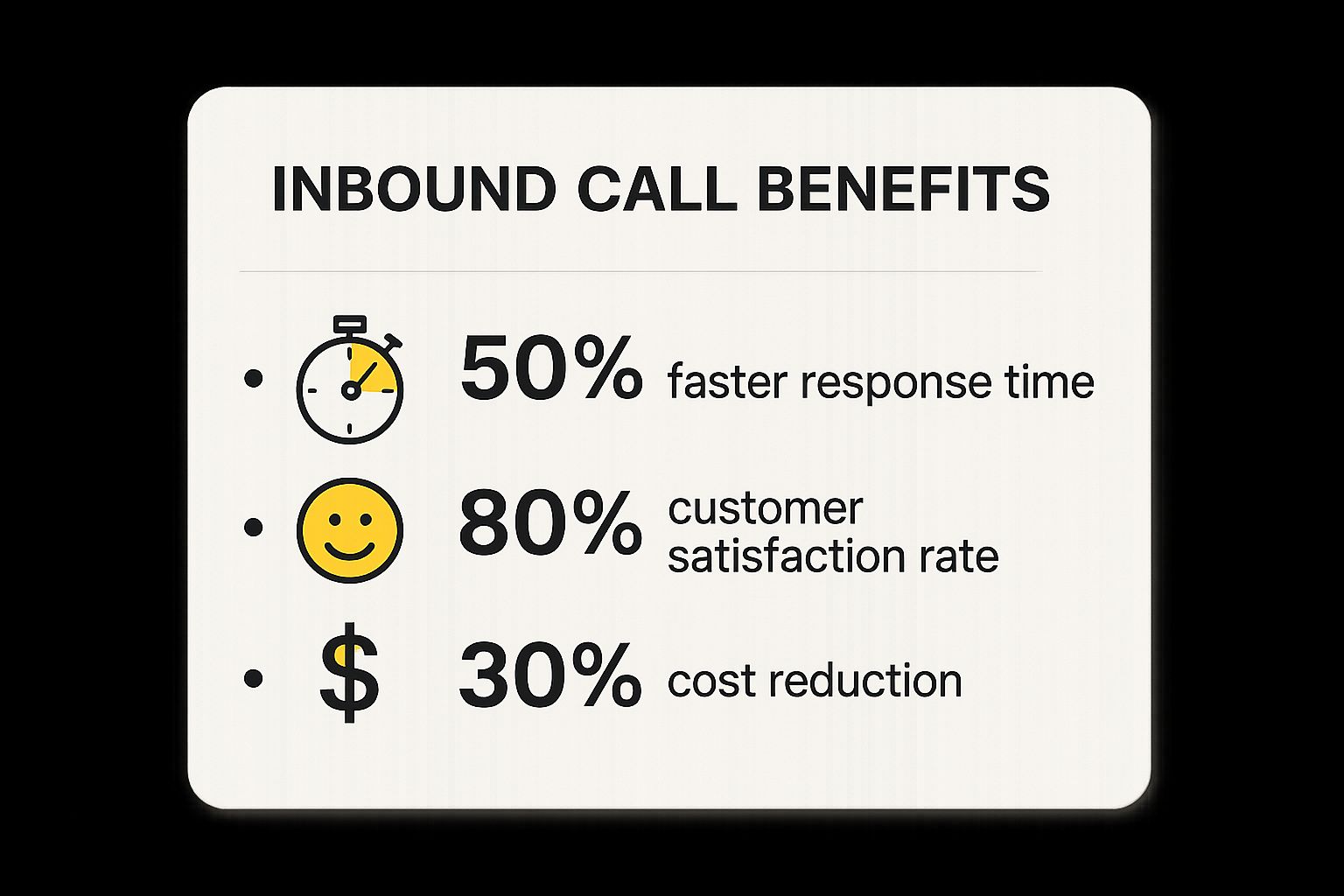When a customer picks up the phone and calls your business, that's an inbound call. But it’s much more than just a phone ringing. To truly understand the inbound call meaning, you need to see it for what it is: a customer proactively reaching out, usually with a specific question, a problem that needs solving, or a clear intention to buy.
What Does an Inbound Call Really Mean for Your Business?

Let's look past the textbook definition. An inbound call is a real moment of truth for your business. Think of it like this: instead of you having to hit the pavement to find customers, one has just walked straight into your shop. They've already done the heavy lifting—they found your number, realised they need something, and made the decision to connect with you.
That one action says a lot. It shows they're interested and have a genuine reason to talk, making them a high-value contact. Unlike marketing where you're pushing a message out to a broad audience, an inbound call pulls a ready-to-engage person in. Every ring is an opportunity.
To give you a clearer picture, here's a quick rundown of what defines an inbound call.
Quick Guide to Inbound Call Characteristics
| Characteristic | Description |
|---|---|
| Initiated by the Customer | The customer or prospect makes the first move to contact the business. |
| Reactive for the Business | Your team is responding to a need, not creating one. |
| High Intent | The caller usually has a specific reason for calling (e.g., support, sales). |
| High Value | These leads are often warmer and more qualified than outbound contacts. |
This table shows that these aren't just random calls; they're direct lines to people who already have your business on their radar.
The Opportunity in Every Ring
Every inbound call generally falls into one of a few key categories, and each one holds potential for your business to grow. Getting a handle on these is central to seeing the full picture.
- Customer Support: This is the most common one. Existing customers call for help, to report an issue, or ask a question. A good experience here can build incredible loyalty.
- Sales Enquiries: These are basically warm leads served up on a platter. The caller is actively thinking about your product or service and just needs that last bit of info to make a decision.
- General Information: People might be ringing to ask about your opening hours, location, or basic services. This is your chance to make a brilliant first impression.
An inbound call is your business's front line for customer experience. The way it's handled has a direct impact on customer satisfaction, retention, and your brand's reputation right here in the Australian market.
At the end of the day, these calls aren't just interruptions to your workday; they are the work. They give you direct feedback, shine a light on customer pain points, and open up clear paths to revenue. For any Aussie business, mastering how you handle these interactions is non-negotiable if you want to build lasting success and strong relationships with the people who matter most—your customers.
Inbound vs Outbound Calls: Understanding the Critical Differences
To really get a handle on what makes an inbound call so important, it helps to put it side-by-side with its opposite: the outbound call. The difference isn't just about who dials the number; it’s about two completely different ways of doing business and shaping the customer experience.
Think of an inbound call as reactive. A customer has a question, a problem, or a need, and they're the ones reaching out to you for a solution. The whole interaction starts on a positive note because they already have an interest. They're coming to you for help, which sets a helpful, service-focused tone from the get-go.
An outbound call, on the other hand, is proactive. Your business makes the first move, whether it's for sales, marketing surveys, or follow-ups. The big challenge here is to spark interest where it might not exist. It's like a customer walking into your shop (inbound) versus you knocking on a stranger's door (outbound).
Goals and Mindset
The customer's frame of mind is worlds apart in these two scenarios. Someone calling you is looking for answers and expects efficient, helpful service. But the person on the receiving end of an outbound call is often caught off guard and might be a bit sceptical or defensive.
This difference completely changes how you should communicate. For tradies, getting the inbound flow right is make-or-break, and there are specific tradie call management tips that can turn a ringing phone from a headache into a massive asset.
The data below really drives home just how powerful a well-oiled inbound system can be.

These numbers don't lie. Putting a real focus on your inbound calls pays off big time, leading to better efficiency, happier customers, and serious cost savings.
To make things even clearer, let's look at a direct comparison.
Inbound vs Outbound Calls: A Head-to-Head Comparison
This table breaks down the core differences between inbound and outbound calls, showing how they diverge in their goals, tone, and what success looks like.
| Aspect | Inbound Calls | Outbound Calls |
|---|---|---|
| Primary Goal | Customer service and support, handling warm sales leads. | Lead generation, cold sales, market research. |
| Communication Tone | Empathetic, helpful, and focused on finding a solution. | Persuasive, assertive, and aimed at creating engagement. |
| Customer Expectation | A quick solution and expert help from someone who knows their stuff. | Often unexpected; requires you to quickly show value. |
| Success Metrics | First Call Resolution, Customer Satisfaction (CSAT) scores. | Conversion Rate, Calls Per Hour, Sales Volume. |
At the end of the day, it all boils down to this: inbound communication is about skillfully and empathetically looking after the interest someone already has in your business. It’s about turning a simple phone call into a fantastic brand experience. Outbound is about creating brand new opportunities through sheer persistence and persuasive skill.
The Impact of Inbound Calls on Australian Industries

In Australia's bustling, service-heavy economy, knowing the inbound call meaning isn't just theory—it’s a matter of survival. For countless Aussie businesses, especially in fields like finance, tourism, and real estate, inbound calls are the main artery for customer conversations and, ultimately, revenue.
Think about it. These calls offer a direct line into what your customers are thinking and feeling. When someone rings their bank about a mortgage, a travel agent to lock in a holiday, or their telco to sort out an internet drama, that single phone call shapes their entire view of your brand.
Handling these calls exceptionally well is no longer just a "nice to have"; it's a non-negotiable part of business strategy. Aussies have high standards for service. They want fast, efficient, and personal support. A fumbled call can easily mean a lost customer, whereas a brilliant experience can lock in their loyalty for years to come.
Connecting National Trends to Call Volumes
The number of calls coming in doesn't just happen in a bubble. It’s directly linked to the bigger economic and social shifts happening right across the country.
A great example is how travel and migration patterns boost demand for support services. In May 2025, Australia saw a 12.2% jump in total arrivals compared to the year before. That kind of surge naturally means more inbound calls to airlines, hotels, and government departments. You can dive into more of these Australian travel statistics at the ABS.
Inbound call management isn't just about picking up the phone. It's about having the right systems to cope with changing demand and consistently delivering a top-notch customer experience.
As these trends roll on, Australian businesses are shifting their mindset from simply reacting to calls. They're now actively investing in technology to get ahead of customer needs, make their workflows smoother, and ensure every single inbound call strengthens their customer relationships. The goal is to turn a simple question into a positive, memorable moment with the brand.
Of course! Here is the rewritten section, crafted to sound like an experienced human expert and match the provided blog post examples.
How to Measure Inbound Call Performance That Matters
Knowing what an inbound call is is one thing, but figuring out if you're actually any good at handling them? That's where the real magic happens. If you can't measure it, you can't improve it.
Forget the confusing corporate jargon. To get a real sense of how your business is performing, you need to focus on a few key performance indicators (KPIs) that tell the true story of your customer experience. These aren't just numbers on a spreadsheet; they're the vital signs of your business.
Think of it this way: these metrics tell you how quickly you’re picking up the phone, how well you’re solving problems, and, crucially, how many customers are getting fed up and hanging up before you even get a chance to say hello.
Core Metrics for Inbound Success
To get a clear picture of what's going on, start by tracking these essential KPIs. They’ll give you an immediate look into how smoothly your operation is running and how happy (or unhappy) your customers are.
- Average Wait Time (AWT): This is simply how long a customer sits on hold before a real person answers. A long wait is probably the fastest way to turn a potential customer into a frustrated one.
- Abandonment Rate: This is the percentage of people who hang up before they even reach you. A high number here is a massive red flag, usually pointing to ridiculously long wait times or a confusing phone menu that’s driving people away.
- First Contact Resolution (FCR): This tracks how many issues you solve in a single phone call, with no need for a follow-up. A high FCR is a brilliant sign of an efficient team and happy customers. The better your crew is at handling calls, the higher this number will be. For some extra tips, check out our guide on how to answer the phone professionally.
When you focus on FCR, you're not just closing a support ticket. You're showing your customer you respect their time and that your business is competent. It's a direct reflection of how well you meet their needs.
So, what does 'good' actually look like in Australia? Local inbound call centres aim for pretty high standards. According to Australian contact centre benchmarks, the industry benchmark for average wait time is around 28 seconds, and the goal for abandonment rate is to keep it under 5%.
Top-performing teams also shoot for a First Contact Resolution rate somewhere between 70% and 75%.
Keeping an eye on these figures gives you a solid framework to see how your own team stacks up. It pinpoints exactly where you can make changes to serve your customers better and keep them coming back.
The Technology Transforming Inbound Call Management

The days of a lonely phone sitting on a desk are well and truly behind us. These days, smart technology is completely shaking up how businesses handle inbound calls, turning a once-simple reactive chore into a strategic, data-rich operation. And we're not talking about flashy gadgets; these are essential tools for any business that wants to stay in the game.
Modern systems use clever tech to make every single call smoother and more effective for everyone involved. Instead of a customer getting stuck on hold and bounced between departments like a pinball, smart systems get them to the right person, right away.
This move from manual handling to smart automation means businesses can now manage a much higher volume of calls without ever letting quality slip. It’s all about working smarter, not just harder, to deliver the kind of service Australian customers have come to expect.
The Key Technologies In Play
So, what’s actually powering all this behind the scenes? It usually boils down to a powerful trio of technologies working in harmony to make every inbound call count.
- Interactive Voice Response (IVR): You've definitely met this one before. It’s the automated menu you hear when you call a business (“Press 1 for sales…”). A well-designed IVR system lets customers direct themselves to the right department or even solve simple queries on their own. This frees up your human team to tackle the more complex problems.
- Customer Relationship Management (CRM) Integration: This is a huge one. When a call comes in, CRM integration instantly pops up that customer's entire history on your agent's screen. They can see past purchases, previous support tickets, and contact details, which lets them have a much more personal and efficient chat. No more asking, "Can you spell your name for me again?"
- Artificial Intelligence (AI): AI is the real game-changer here. It’s the brains behind intelligent call routing, which can analyse a caller's needs and instantly send them to the best-equipped agent. It also drives real-time transcription and sentiment analysis, giving agents live feedback on the tone of the call.
These technologies aren't some far-off futuristic idea; they are practical, everyday tools making a real difference for businesses right now. In fact, using them has shifted from a luxury to a baseline expectation for good customer communication.
Recent research shows just how mainstream this tech has become. The 2025 Australian Contact Centre Industry Best Practice Report found that 64% of local contact centres say AI is meeting or even exceeding their expectations. That’s a massive jump from just 47% the previous year. You can dive deeper into these contact centre technology trends and their impacts to see for yourself.
This widespread adoption is made possible by specialised call management software that bundles all these features into one seamless system. For any Aussie business looking to get ahead, embracing this technology is the key to boosting efficiency and keeping your customers happy.
Your Questions on Inbound Calls Answered
To wrap things up, let's tackle some of the most common questions people have about inbound calls. We’ll get into the nitty-gritty of setting up a system, what an inbound centre is really for, and the must-have skills for any agent who answers the phone.
Think of this as your quick-fire round to fill in any gaps. It’s all about making sure you feel confident in how you handle your business communications.
The real takeaway here is that an inbound call is never just a call. It’s a direct signal of customer interest and an opportunity to build trust, solve a problem, or make a sale. Getting it right is fundamental to keeping your customers happy and loyal.
What Is the Main Purpose of an Inbound Call Centre?
At its core, the main purpose of an inbound call centre is to be the first point of contact for any communication started by a customer. This usually means providing customer service, sorting out technical issues, answering questions about products, and processing orders.
It’s the polar opposite of an outbound centre, which is all about making proactive calls. An inbound centre is purely reactive, making it the frontline for keeping customer satisfaction and loyalty high.
How Do You Set Up an Inbound Call System for a Small Business?
For a small business, you don't need to overcomplicate it. Kicking things off can be as simple as getting a dedicated business phone number.
As you start getting more calls, it’s worth looking into a Voice over IP (VoIP) service. These systems are budget-friendly and pack a professional punch with features like call routing, sending voicemails to your email, and basic automated menus (IVR). The trick is to find a system that nails your current needs but has the legs to grow with you.
What Skills Are Essential for an Inbound Call Agent?
If you're hiring an inbound agent, a few skills are non-negotiable. Top of the list are active listening, empathy, and clear communication. These are the tools that allow an agent to truly understand what a customer needs and sort it out properly.
Strong problem-solving skills are also a game-changer, especially for fixing issues on the first call. And you can't forget patience, resilience, and solid product knowledge—they're vital for navigating tricky conversations and giving out information that’s actually helpful.
Stop letting missed calls dictate your day. OnSilent filters the noise and organises your communications so you can focus on what truly matters. Reclaim up to eight hours a week and never miss an important opportunity again. Learn more about how you can take back control.

